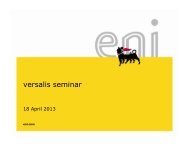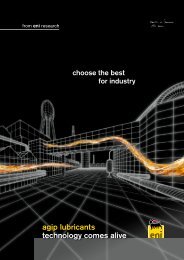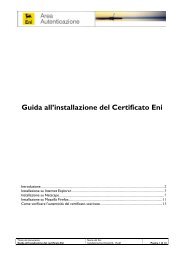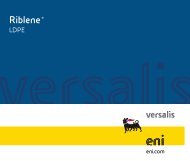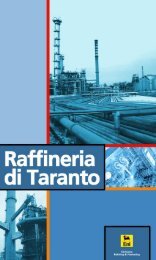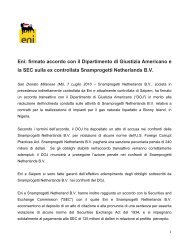È in corso il restauro conservativo del Duomo di Milano. Un ... - Eni
È in corso il restauro conservativo del Duomo di Milano. Un ... - Eni
È in corso il restauro conservativo del Duomo di Milano. Un ... - Eni
You also want an ePaper? Increase the reach of your titles
YUMPU automatically turns print PDFs into web optimized ePapers that Google loves.
SCENARI - SCENARIOS<br />
ca, si sono evoluti i sistemi <strong>di</strong> perforazione, gli scalpelli,<br />
le macch<strong>in</strong>e movimento terra, i materiali, le tecniche anti-corrosione,<br />
i cementi, i fanghi… Il confronto fra le<br />
due enciclope<strong>di</strong>e mette <strong>in</strong> luce, non solo <strong>il</strong> grande sv<strong>il</strong>uppo<br />
tecnologico, ma anche <strong>il</strong> profondo cambiamento<br />
culturale. Negli anni Sessanta, l’attività petrolifera, richiedeva<br />
soprattutto molta esperienza pratica. I calcoli<br />
spesso si facevano a mano o con la calcolatrice. Oggi le<br />
cose sono cambiate: la pratica è ancora importante ma<br />
non basta. Le tecniche <strong>in</strong>formatiche ed elettroniche permettono<br />
<strong>di</strong> elaborare una quantità enorme <strong>di</strong> dati, r<strong>il</strong>evati<br />
attraverso satelliti, prospezioni aeree, tecniche sismiche<br />
sempre più sofisticate… Ci vuole qualcuno che<br />
conosca le tecniche e gli strumenti per ut<strong>il</strong>izzare questa<br />
mole <strong>di</strong> <strong>in</strong>formazioni”.<br />
“<strong>Un</strong>a volta, la raccolta dei dati”, ricorda Mazzei, “avveniva<br />
<strong>in</strong> settori separati. C’era una sezione Campo che stu<strong>di</strong>ava<br />
la conformazione probab<strong>il</strong>e <strong>del</strong> giacimento e un’altra<br />
sezione che stu<strong>di</strong>ava i fenomeni d<strong>in</strong>amici: pressioni,<br />
temperatura, acqua, produzione <strong>di</strong> gas… Oggi, <strong>in</strong>vece, le<br />
due <strong>di</strong>scipl<strong>in</strong>e sono <strong>in</strong>tegrate: lo stu<strong>di</strong>o <strong>di</strong> un giacimento<br />
è un lavoro <strong>di</strong> gruppo che va dal geologo al geofisico, f<strong>in</strong>o<br />
al mo<strong>del</strong>lista”.<br />
“La tecnica <strong>di</strong> r<strong>il</strong>evazione a tre <strong>di</strong>mensioni”, aggiunge<br />
Brighenti, “ha consentito una conoscenza più dettagliata<br />
<strong>del</strong> sottosuolo. Ora parliamo <strong>di</strong> sistema quadri<strong>di</strong>mensionale.<br />
La quarta variab<strong>il</strong>e è quella temporale che permette<br />
<strong>di</strong> conoscere <strong>in</strong> tempo reale le variazioni <strong>del</strong>le caratteristiche<br />
<strong>del</strong> giacimento”.<br />
“Oggi, tutto <strong>il</strong> processo che va dall’esplorazione alla produzione”,<br />
precisa Mazzei, “è <strong>in</strong>tegrato e ottimizzato. Attraverso<br />
la sismica, si ottengono <strong>in</strong>formazioni ut<strong>il</strong>i anche<br />
nelle fasi successive <strong>del</strong>la messa <strong>in</strong> produzione e gestione<br />
<strong>del</strong> giacimento. Le tecnologie <strong>di</strong> monitoraggio permettono<br />
<strong>di</strong> riaggiustare i mo<strong>del</strong>li <strong>in</strong> tempo reale, man<br />
mano che va avanti la produzione…”.<br />
Nuove tecnologie, nuove frontiere. “L’uso sp<strong>in</strong>to <strong>del</strong>l’elettronica<br />
e <strong>del</strong>l’<strong>in</strong>formatica”, spiega Barnaba, “ha consentito<br />
lo sv<strong>il</strong>uppo <strong>di</strong> nuove tecniche <strong>di</strong> prospezione, <strong>di</strong><br />
perforazione, <strong>di</strong> gestione <strong>del</strong> giacimento, che hanno rivoluzionato<br />
molte fasi <strong>del</strong>l’attività petrolifera, consentendo<br />
risultati notevolmente superiori rispetto alle tecnologie<br />
L’ITALIA E IL METANO. Caviaga, <strong>il</strong> primo grande giacimento<br />
a gas naturale <strong>in</strong> Italia e nell’Europa Occidentale,<br />
scoperto nel 1944. Prima <strong>di</strong> questo campo erano stati<br />
scoperti solo giacimenti <strong>di</strong> modeste <strong>di</strong>mensioni.<br />
<strong>È</strong> stata questa la prima grande <strong>in</strong>tuizione <strong>di</strong> Enrico<br />
Mattei che ha portato alla scoperta <strong>di</strong> altri giacimenti<br />
nella Pianura Padana e nel resto <strong>del</strong> paese. In alto,<br />
<strong>il</strong> Centro <strong>di</strong> Visualizzazione Avanzata (AVC) realizzato<br />
dall’<strong>Eni</strong>. Grazie a tecnologie <strong>in</strong>novative, <strong>il</strong> centro<br />
consente la percezione realistica <strong>di</strong> oggetti, mo<strong>del</strong>li<br />
e <strong>in</strong>formazioni grafiche tri<strong>di</strong>mensionali.<br />
ITALY AND NATURAL GAS. Caviaga, the first large natural gas<br />
field <strong>in</strong> Italy and Western Europe, <strong>di</strong>scovered <strong>in</strong> 1944. Earlier<br />
only modest fields had been <strong>di</strong>scovered. This was the first great<br />
<strong>in</strong>tuition by Enrico Mattei, which led to the <strong>di</strong>scovery of more<br />
fields <strong>in</strong> the Po River Valley and elsewhere <strong>in</strong> Italy. Above,<br />
the Advanced Visualization Centre (AVC) set up by <strong>Eni</strong>.<br />
Thanks to its cutt<strong>in</strong>g edge technologies, the Centre makes<br />
it possible to have a realistic perception of objects, mo<strong>del</strong>s<br />
and 3D graphic <strong>in</strong>formation.<br />
convenzionali, sia nella fase esplorativa sia <strong>in</strong> quella <strong>del</strong>lo<br />
sv<strong>il</strong>uppo. Pensiamo, per esempio, ai pozzi orizzontali o<br />
alle tecniche per <strong>il</strong> recupero avanzato, che permettono <strong>di</strong><br />
estrarre dal giacimento una quantità <strong>di</strong> greggio molto<br />
maggiore <strong>di</strong> quella che era possib<strong>il</strong>e estrarre quarant’anni<br />
fa. Inoltre sono state sv<strong>il</strong>uppate tecniche che riducono<br />
notevolmente i costi <strong>di</strong> perforazione e l’impatto ambientale…<br />
Inf<strong>in</strong>e, la ‘fame’ <strong>di</strong> energia ha <strong>in</strong><strong>di</strong>rizzato le compagnie<br />
anche verso obiettivi <strong>di</strong> frontiera, come lo sv<strong>il</strong>uppo<br />
<strong>di</strong> giacimenti <strong>in</strong> acque profonde, che prima non si prendevano<br />
neanche <strong>in</strong> considerazione…”.<br />
Acque profonde e campi marg<strong>in</strong>ali. Il capitolo de<strong>di</strong>cato<br />
all’evoluzione <strong>del</strong>le piattaforme a mare è, forse, quello<br />
che più affasc<strong>in</strong>a anche i non addetti ai lavori. In Europa,<br />
<strong>il</strong> primo pozzo offshore fu perforato dall’<strong>Eni</strong> al largo <strong>di</strong><br />
Gela ed entrò <strong>in</strong> produzione nel 1961. Per molti anni, l’attività<br />
petrolifera offshore è stata limitata ad acque la cui<br />
profon<strong>di</strong>tà non superava i 3-400 metri, dove è possib<strong>il</strong>e<br />
<strong>in</strong>stallare piattaforme fissate sul fondo, con caratteristiche<br />
analoghe a quelle terre-<br />
stri. Poi si è com<strong>in</strong>ciato a<br />
esplorare e mettere <strong>in</strong> produzione<br />
gran<strong>di</strong> giacimenti a profon<strong>di</strong>tà<br />
d’acqua <strong>di</strong> oltre m<strong>il</strong>le,<br />
duem<strong>il</strong>a metri, dove le piattaforme<br />
tra<strong>di</strong>zionali non potevano<br />
essere ut<strong>il</strong>izzate. Così<br />
sono state concepite le tension<br />
leg platform, piattaforme<br />
galleggianti ancorate e<br />
collegate ai pozzi con dei riser,<br />
tubi flessib<strong>il</strong>i…<br />
Lo sforzo <strong>di</strong> valorizzare al<br />
massimo le risorse <strong>di</strong> idrocarburi<br />
ha portato allo sv<strong>il</strong>uppo<br />
<strong>di</strong> sistemi e <strong>di</strong> tecnologie rivolte<br />
a rendere economico<br />
THE PETROLEUM AGE<br />
The first volume of the new encyclopae<strong>di</strong>a<br />
is devoted to the hydrocarbon <strong>in</strong>dustry<br />
and its evolution. The three e<strong>di</strong>tors,<br />
Pier Federico Barnaba, Giovanni Brighenti<br />
and Renato Mazzei, talk about its values<br />
and contents.<br />
by LUIGI VALGIMIGLI<br />
BACK FROM THE PRINTERS, SMELLING OF PAPER AND<br />
<strong>in</strong>k, the first volume of the Encyclopae<strong>di</strong>a of<br />
Hydrocarbons, is elegant <strong>in</strong> its typeface, design, and<br />
pictures. Ugo Romano and the three coord<strong>in</strong>ators of the<br />
volume flip through it emotionally: “We have worked a lot, pay<strong>in</strong>g<br />
attention to even the smallest of deta<strong>il</strong>s.” In a few days, the<br />
English copy arrives. “This, too, is a new development from the<br />
first Encyclopae<strong>di</strong>a of O<strong>il</strong> and Gas,” commented Ugo Romano,<br />
jo<strong>in</strong>t project <strong>di</strong>rector of the work together with Mario Beccari of<br />
Rome’s La Sapienza university.<br />
The volume covers all the phases of the hydrocarbon <strong>in</strong>dustry,<br />
from the geosciences to exploration, to the <strong>di</strong>scovery and<br />
development of a field, to the problems connected to the<br />
abandonment of exhausted or no longer economically viable<br />
fields. It also looks at the subjects of transport and storage of<br />
o<strong>il</strong> and natural gas.<br />
These are issues that are much <strong>di</strong>scussed today. Usually,<br />
however, when we f<strong>il</strong>l up our cars or light the blue flame <strong>in</strong> our<br />
ovens or bo<strong>il</strong>ers, we are not aware that the ava<strong>il</strong>ab<strong>il</strong>ity of o<strong>il</strong> and<br />
gas is not a present from nature but that it depends on the work<br />
of hundreds of thousands of people who, all over the world, da<strong>il</strong>y<br />
face small and large technological, bus<strong>in</strong>ess, economic,<br />
environmental, f<strong>in</strong>ancial, and social and political challenges.<br />
The encyclopae<strong>di</strong>a highlights the evolution of this multi<strong>di</strong>mensional<br />
commitment <strong>in</strong> a sector, hydrocarbons, that supplies<br />
the world with more than 60 percent of its energy needs.<br />
Exploration and production: an <strong>in</strong>tegrated process. What are<br />
the ma<strong>in</strong> <strong>di</strong>fferences between the 1962 e<strong>di</strong>tion and that of<br />
today? It comes natural to ask of the three coord<strong>in</strong>ators of the<br />
volume, Pier Federico Barnaba of the <strong>Un</strong>iversity of M<strong>il</strong>an,<br />
Department of Earth Sciences; Giovanni Brighenti of the<br />
<strong>Un</strong>iversity of Bologna, Department of M<strong>in</strong><strong>in</strong>g Chemistry and<br />
Environmental Technology; and Renzo Mazzei, geologist and<br />
collaborator with the Mattei School.<br />
Ugo Romano <strong>in</strong>troduced the <strong>di</strong>scussion. “What is imme<strong>di</strong>ately<br />
strik<strong>in</strong>g”, he stated, “is a greater complexity of the o<strong>il</strong> and gas<br />
<strong>in</strong>dustry and a greater <strong>in</strong>tegration <strong>in</strong> all phases of<br />
multi<strong>di</strong>scipl<strong>in</strong>ary sk<strong>il</strong>ls which <strong>in</strong> the past operated <strong>di</strong>sjo<strong>in</strong>tedly,<br />
almost <strong>in</strong> separate compartments. This consideration has<br />
conv<strong>in</strong>ced us to give the encyclopae<strong>di</strong>a such a perspective as<br />
to allow for an overall vision of the subjects: that is, a thematic<br />
approach, capable of look<strong>in</strong>g <strong>in</strong> an <strong>in</strong>tegrated way at the<br />
problems that, along with the techno-scientific aspects, also<br />
<strong>in</strong>volve issues of a more general character.”<br />
“A large part of technological development”, cut <strong>in</strong> Brighenti, “is<br />
a response to economic, environmental, safety, and susta<strong>in</strong>able<br />
development challenges. The easiest fields have now largely<br />
been <strong>di</strong>scovered and are <strong>in</strong> an advanced stage of exploitation.<br />
The o<strong>il</strong> <strong>in</strong>dustry has to look at more <strong>di</strong>fficult fields that are often<br />
to be found <strong>in</strong> host<strong>il</strong>e environments or <strong>in</strong> vulnerable areas with<br />
<strong>del</strong>icate ecosystems, ever further away from where consumers<br />
live. O<strong>il</strong> companies today need to burden themselves with the<br />
utmost respect for environmental and socio-economic balances<br />
<strong>in</strong> the areas where they operate.”<br />
From the calculator to big processors. The encyclopae<strong>di</strong>a<br />
sheds light on an extraord<strong>in</strong>ary technological development,<br />
unimag<strong>in</strong>able <strong>in</strong> Mattei’s era. “Suffice it to say that the large<br />
calculators that were later used <strong>in</strong> all the most <strong>in</strong>novative<br />
sectors – says Mazzei – orig<strong>in</strong>ated <strong>in</strong> the petroleum sector. At<br />
that time, o<strong>il</strong> companies were the enterprises that could afford<br />
higher <strong>in</strong>vestments”.<br />
“Compared with the 60s, when the first encyclopae<strong>di</strong>a was<br />
published” – Barnaba agrees – “many th<strong>in</strong>gs have changed.<br />
Geophysical evolution was matched by the evolution of dr<strong>il</strong>l<strong>in</strong>g<br />
systems, bits, excavators, materials, anti-corrosion techniques,<br />
cements, muds… The comparison between the two<br />
encyclopae<strong>di</strong>as highlights not only the huge technological<br />
progress, but also the profound cultural change. In the 60s, o<strong>il</strong><br />
activities required plenty of practical expertise. Calculations were<br />
often made by hand or with a calculator. Th<strong>in</strong>gs are pretty<br />
<strong>di</strong>fferent today: practice is st<strong>il</strong>l important, but is not enough. IT<br />
and electronic techniques allow for the process<strong>in</strong>g of a huge<br />
amount of data gathered through satellites, aerial surveys,<br />
<strong>in</strong>creas<strong>in</strong>gly sophisticated seismic techniques… There must be<br />
someone who knows how to handle the techniques and tools to<br />
exploit all this data”.<br />
“Data collection – recalls Mazzei – was once carried out <strong>in</strong><br />
separate sectors. There was a Field section that stu<strong>di</strong>ed the<br />
probable outl<strong>in</strong>e of the field, and another section that stu<strong>di</strong>ed<br />
dynamic phenomena, such as pressures, temperature, water,<br />
gas production… Now, the two branches have merged. Study<strong>in</strong>g<br />
an o<strong>il</strong> field is a team work that ranges from the geologist to the<br />
geophysicist, to the mo<strong>del</strong> designer”.<br />
“The 3D prospect<strong>in</strong>g technique” – adds Brighenti – “has allowed<br />
for a more deta<strong>il</strong>ed knowledge of the subsurface. Now we talk of<br />
a four-<strong>di</strong>mension system. The fourth variable is time, which<br />
50 <strong>Eni</strong>’s Way<br />
<strong>Eni</strong>’s Way<br />
51



